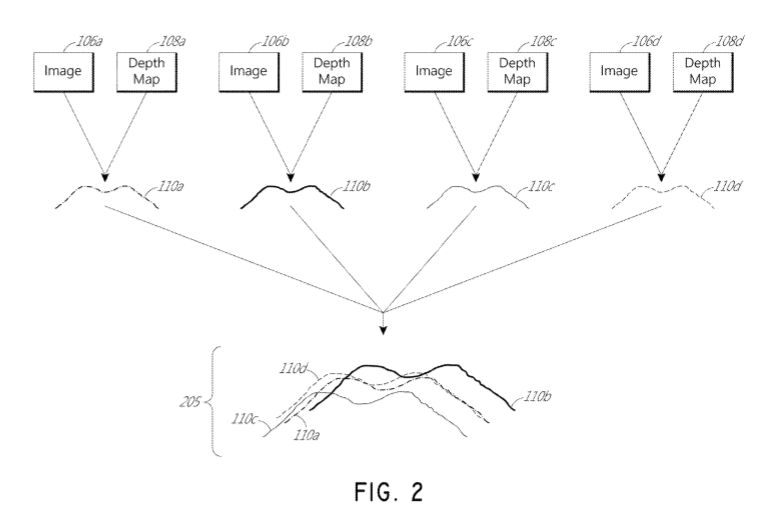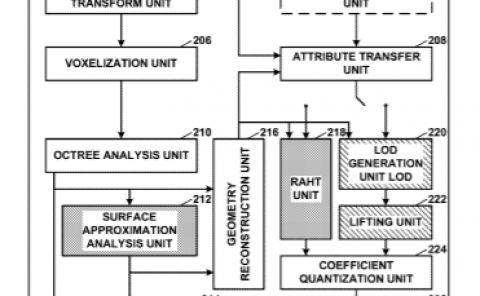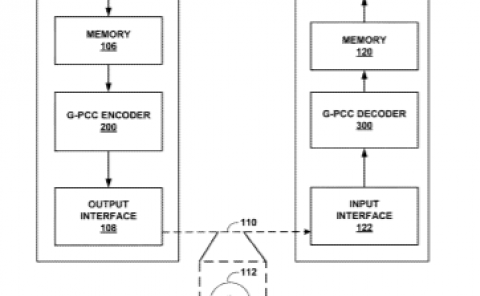Qualcomm Patent | Systems and methods for improved surface normal estimation
Patent: Systems and methods for improved surface normal estimation
Publication Number: 10192345
Publication Date: 2019-01-29
Applicants: Qualcomm

Abstract
Methods and systems for surface normal estimation are disclosed. In some aspects, a plurality of images or depth maps representing a three dimensional object from multiple viewpoints is received. Surface normals at surface points within a single image of the plurality of images are estimated based on surface points within the single image. An electronic representation of a three dimensional surface of the object is generated based on the surface normals and a point cloud comprised of surface points derived from the plurality of images.
Background
Three dimensional surface reconstruction may be based on multiple images and depth maps taken of a three dimensional object. Each of the multiple images and depth maps may be captured from a different viewpoint of the three dimensional object. Point locations on the object may be identified from the images and/or depth maps and used to align the multiple images. An electronic representation of a surface of the three dimensional object may then be created based on the point locations. For example, surface normals at one or more point locations on the surface may be determined. The three dimensional surface between the known surface points may then be estimated based on a neighborhood of surface points and the surface normal estimates. However, in some environments, the resulting three dimensional surface estimation may contain one or more irregularities that reduces the quality of the three dimensional reproduction. Therefore, improved methods of three dimensional surface reconstruction are needed.
Summary
The systems, methods, and devices of this disclosure each have several aspects, no single one of which is solely responsible for its desirable attributes. Without limiting the scope of the disclosure, some aspects of the disclosure are briefly described below.
As discussed above, three dimensional object surface reconstruction may rely on multiple viewpoint images and depth maps to aid in the reconstruction. The reconstruction may include identifying points on the surface of the object being reconstructed. The points may be matched across images to facilitate alignment of the multiple images. Surface normals may be estimated at one or more surface point locations to assist with estimating the orientation of the three dimensional object’s surface at the point location. Based on the individual surface orientations at each of the known point locations, the surface between the known surface points may be “filled in” using a variety of techniques, such as interpolating the orientations between surface points to determine the orientation of the object’s surface between the known points.
When the multiple viewpoint images are not well aligned, the multiple images may indicate different locations within three dimension space for surface points common to the multiple images. This may result in a general reduction in the accuracy of surface normal estimates that are generated based on the misaligned surface points from different images.
To avoid this problem, the disclosed methods and systems may perform surface normal estimation utilizing only surface points within a single image. By using only on points derived from a single image for estimating a surface normal, the accuracy of surface normal estimation may be substantially improved, especially in environments with relatively large levels of misalignment between the multiple viewpoint images. This may also be the case in low luminance environments. For example, when images of the three dimensional object are captured under low lighting conditions, the accuracy of the surface point locations may suffer. For example, some surface points may not be visible under lower lighting conditions, thus reducing a number of surface points that may be utilized for surface normal estimation. Furthermore, low lighting conditions may cause surface point identification algorithms to perform with less reliability and consistency, resulting in variations in identified surface point locations within each of the multiple viewpoint images. Therefore, under lower luminance conditions, it may be beneficial to estimate surface normals using only surface points derived from a single image.
One aspect disclosed is a method of electronically representing a three dimensional surface for an object. The method includes receiving a plurality of images of the object, the images representing the object from a plurality of viewpoints, identifying points on the surface within each of the plurality of images, generating estimates of surface normals for surface points within each corresponding image based on the surface points within the corresponding image, generating a point cloud comprising surface points from each of the plurality of images; and generating a representation of the three dimensional surface for the object based on the surface normal estimates and the point cloud.
In some aspects, the method includes rendering the representation of the three dimensional surface on an electronic display. In some aspects, the method includes identifying first surface points within a first image of the plurality of images, identifying second surface points within a second image of the plurality of images, generating first estimates of surface normals at first surface point locations based on the first surface points, generating second estimates of surface normals at second surface point locations based on the second surface points, and generating the representation of the three dimensional surface based on the first estimates and second estimates of surface normals.
In some aspects, the method includes filling in the representation of the three dimensional surface between the surface points based on the point cloud, and the first and second surface normal estimates. In some aspects, the method selectively generating the estimates based on one or more of an indication of misalignment between the multiple images and a luminance level of the three dimensional object in the plurality of images. In some aspects, the method includes generating first estimates for surface points within a first image of the plurality of images based on surface points within other images of the plurality of images in response to the misalignment being greater than a threshold, and generating the first estimates for surface points within the first image based on surface points within the single first image in response to the misalignment being lower than the threshold. In some aspects, the method includes generating first estimates for surface points within a first image of the plurality of images based on surface points within other images of the plurality of images in response to the luminance being less than a threshold, and generating the first estimates for surface points within the first image based on surface points within the single first image in response to the luminance being greater than the threshold.
In some aspects, the method includes generating second estimates of surface normals for surface points of a first image of the plurality of images based on surface points identified in multiple images of the plurality of images, comparing the first estimates with the second estimates; and generating the representation of the three dimensional surface in response to the comparison. In some aspects, the method includes estimating a consistency between surface normals of the first estimates and a consistency between surface normals of the second estimates, generating the representation of the three dimensional surface based on the more consistent surface normal estimates.
Another aspect disclosed is an apparatus for electronically representing a surface of a three dimensional object. The apparatus includes an electronic hardware processor, an electronic hardware memory storing instructions that when executed, cause the processor to receive a plurality of images of the object, the images representing the object from a plurality of viewpoints, identify surface points on the surface within each of the plurality of images, generate estimates of surface normals for surface points within each corresponding image based on the surface points within the corresponding image, generate a point cloud comprising surface points from each of the plurality of images; and generate a three dimensional surface for the three dimension object based on the surface normal estimates and the point cloud.
In some aspects, the apparatus includes an electronic display, and the electronic memory stores further instructions that cause the electronic hardware processor to render the three dimensional surface on the electronic display. In some aspects, the electronic hardware memory stores further instructions that cause the electronic hardware processor to: identify first surface points within a first image of the plurality of images, identify second surface points within a second image of the plurality of images, generate first estimates of surface normals at first surface point locations based on the first surface points, generate second estimates of surface normals at second surface point locations based on the second surface points; and generate the surface estimation based on the first estimates and second estimates of surface normals. In some aspects, the electronic hardware memory stores further instructions that cause the electronic hardware processor to fill in the three dimensional surface between the surface points based on the point cloud, and the first and second surface normal estimates.
In some aspects, the electronic hardware memory stores further instructions that cause the electronic hardware processor to selectively generate the first estimates based on one or more of an indication of misalignment between the multiple images and a luminance level of the three dimensional object in the plurality of images. In some aspects, the electronic hardware memory stores further instructions that cause the electronic hardware processor to generate the first estimates for surface points within a first image of the plurality of images based on surface points within other images of the plurality of images in response to the misalignment being greater than a threshold, and generating the first estimates for surface points within the first image based on surface points within the single first image in response to the misalignment being lower than the threshold.
In some aspects, the electronic hardware memory stores further instructions that cause the electronic hardware processor to generate the first estimates for surface points within a first image of the plurality of images based on surface points within other images of the plurality of images in response to the luminance being less than a threshold, and generating the first estimates for surface points within the first image based on surface points within the single first image in response to the luminance being greater than the threshold. In some aspects, the electronic hardware memory stores further instructions that cause the electronic hardware processor to: generate second estimates of surface normals for each of the first points based on the point cloud, compare the first estimates with the second estimates; and generate the surface estimation in response to the comparison. In some aspects, of the apparatus, the electronic hardware memory stores further instructions that cause the electronic hardware processor to: estimate a consistency between surface normals of the first estimates and a consistency between surface normal of the second estimates, and generate the surface estimation based on the more consistent surface normal estimates.
Another aspect disclosed is a non-transitory computer readable storage medium comprising instructions that when executed cause an electronic hardware processor to perform a method of generating an electronic representation of a three dimensional surface of an object.
The method of the computer readable storage medium includes receiving a plurality of images of the object, the images representing the object from a plurality of viewpoints, identifying surface points on the surface within each of the plurality of images, generating estimates of surface normals for surface points within each corresponding image based on the surface points within the corresponding image, generating a point cloud comprising surface points from each of the plurality of images; and generating a representation of the three dimensional surface for the object based on the surface normal estimates and the point cloud.
In some aspects, the method of the computer readable storage medium includes rendering the representation of the three dimensional surface on an electronic display. In some aspects, the method includes identifying first surface points within a first image of the plurality of images, identifying second surface points within a second image of the plurality of images, generating first estimates of surface normals at first surface point locations based on the first surface points, generating second estimates of surface normals at second surface point locations based on the second surface points, and generating the representation of the three dimensional surface based on the first estimates and second estimates of surface normals.
In some aspects, the method of the computer readable storage medium includes filling in the representation of the three dimensional surface between the surface points based on the point cloud, and the first and second surface normal estimates. In some aspects, the method selectively generating the estimates based on one or more of an indication of misalignment between the multiple images and a luminance level of the three dimensional object in the plurality of images. In some aspects, the method includes generating first estimates for surface points within a first image of the plurality of images based on surface points within other images of the plurality of images in response to the misalignment being greater than a threshold, and generating the first estimates for surface points within the first image based on surface points within the single first image in response to the misalignment being lower than the threshold. In some aspects, the method of the computer readable storage medium includes generating first estimates for surface points within a first image of the plurality of images based on surface points within other images of the plurality of images in response to the luminance being less than a threshold, and generating the first estimates for surface points within the first image based on surface points within the single first image in response to the luminance being greater than the threshold.
In some aspects, the method of the computer readable storage medium includes generating second estimates of surface normals for surface points of a first image of the plurality of images based on surface points identified in multiple images of the plurality of images, comparing the first estimates with the second estimates; and generating the representation of the three dimensional surface in response to the comparison. In some aspects, the method includes estimating a consistency between surface normals of the first estimates and a consistency between surface normals of the second estimates, generating the representation of the three dimensional surface based on the more consistent surface normal estimates.
Another aspect disclosed is an apparatus for electronically representing a surface of a three dimensional object. The apparatus includes a means for receiving a plurality of images of the object, the images representing the object from a plurality of viewpoints, identify surface points on the surface within each of the plurality of images, means for generating estimates of surface normals for surface points within each corresponding image based on the surface points within the corresponding image, means for generating a point cloud comprising surface points from each of the plurality of images; and means for generating a three dimensional surface for the three dimension object based on the surface normal estimates and the point cloud.
Another aspect disclosed is an apparatus for improved rendering of three dimensional objects on a computer, the apparatus includes means for estimating surface normals responsive to a misalignment between multiple images representing the three dimensional object, and means for generating the surface of the three dimensional object based on the surface normals. This aspect may also include means for writing the generated surface to a data store.
Another aspect disclosed is an apparatus for improved rendering of three dimensional objects on a computer, the apparatus includes means for estimating surface normals responsive to a luminance of the three dimensional object across multiple images representing the three dimensional object, and means for generating the surface of the three dimensional object based on the surface normals. This aspect may also include means for writing the generated surface to a data store.



